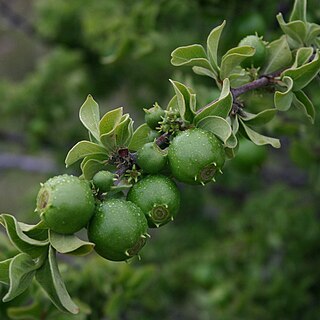It is a small sturdy shrub or small tree. It usually loses its leaves during the year. It grows 3-8 m tall. It is often branched from the base. It has a rounded crown. The branches and twigs are crooked and twisted. The leaves are simple and almost stalkless. They are opposite or in clusters often near the ends of twigs. They are 1.9-3.8 cm long and egg shaped. The tips are rounded but often with a jutting point. The leaves are soft and pale green. The flowers are small, hairy, greenish and bell-shaped. They have 5 spreading lobes. The fruit is round. It is 1.3 cm across. It is green and turns light brown or red. It is edible. There is a stone inside.
Leaves sometimes borne on abbreviated lateral shoots, 1–4 × 0.3–3 cm, small, ovate to elliptic or almost round, rounded or very shortly obtusely acuminate at the apex, truncate to rounded at the base, scarcely discolorous, densely velvety on both surfaces; petiole up to 1(3) mm long; stipules connate, soon deciduous, 1–3 mm long, caudate, the appendage 1.5–2 mm long.
Shrub or small tree up to 6 m tall, much branched and spreading; bark grey, ± smooth or slightly flaking; young shoots densely velvety, sometimes ferruginous pubescent, later ± glabrous; lateral branches often nodulose with old stipule bases.
Small tree or shrub, up to 6 m high. Flowers in dense axillary fascicles, subsessile, tomentose. Leaves sessile or petiole 2-3 mm long, lamina round to subovate, tomentose. Flowers green or yellowish green.
Corolla apiculate in bud; greenish-yellow, densely pubescent; tube 1.5–2.5 mm long, with a ring of deflexed hairs within; lobes 2.5 × 1.2, minutely apiculate.
Flowers in dense 3–7-flowered cymes; peduncle ± obsolete; bracts ± obscured by stipule-bases; pedicels 0–2 mm long.
Fruit brown or reddish, 10–15 mm in diameter, subglobose, pubescent, with mostly 3–4 pyrenes.
Pollen presenter c. 1 mm long, ± cylindrical-coroniform, sulcate, 4–5-lobed at the apex.
Calyx tube c. 1.2 mm long, subglobose; lobes 0.8–2 mm long, triangular to oblong.
Style exserted about 1.2 mm.


